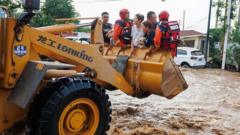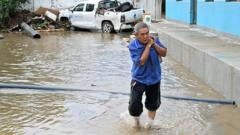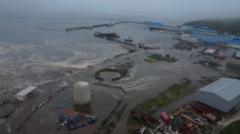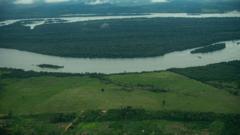As Beijing grapples with devastating floods and landslides, authorities mobilize resources to confront the ongoing natural disasters.
Beijing Floods Result in 30 Deaths Amid Extreme Weather Crisis

Beijing Floods Result in 30 Deaths Amid Extreme Weather Crisis
A summer marked by catastrophic weather events claims lives and challenges rescue efforts in China.
At least 30 lives have been lost in Beijing as torrential rains lead to widespread floods, prompting the evacuation of over 80,000 residents, according to authorities. The deluge in northern China has caused significant damage to infrastructure, with reports of at least eight additional casualties from a landslide in Chengde, three hours to the northeast of the capital.
This summer has unveiled an unprecedented pattern of extreme weather across China, beginning with severe heatwaves earlier this month followed by floods in the southwest regions. In response to the unfolding crisis, President Xi Jinping has ordered comprehensive rescue operations, underscoring the need for preparedness in facing potential disastrous scenarios.
“No effort should be spared to search for and rescue those who are missing or trapped,” he emphasized to rescue services on Monday, highlighting the urgency of transferring affected residents to safer areas. To facilitate recovery and rebuilding efforts, the government has allocated 200 million yuan ($28 million) aimed at repairing vital transportation and infrastructure.
The neighborhoods surrounding Beijing, notably Miyun and Huairou, have been severely affected, witnessing massive flooding that has submerged roadways and left residents cut off from basic services. Reports from the ground detail harrowing scenes of rescue operations as first responders navigate chest-deep waters to reach stranded citizens. Helicopters and drones are being used to deliver much-needed supplies to isolated communities.
Reports from impacted residents show a growing sense of anxiety and desperation. Ms. Yang, a worker from Hebei province, expressed concern for her family living in Miyun, recounting how she lost contact with her elderly parents who require assistance. In her urgency, she turned to social media, pleading for help as floodwaters threatened her family's safety.
Local shop-owner Zhuang Zhelin described the suddenness of the flood's onset, stating, “It was like it came rushing in so quickly.” Fellow survivors recounted being forced to seek shelter on upper floors, reflecting the panic and uncertainty that engulfed the area.
Historically, Beijing has faced flooding challenges, particularly during the summer months, with previous incidents marking significant loss of life. For instance, a deadly flood in July 2012 resulted in 79 deaths. The ongoing flooding crisis emphasizes the escalating pattern of extreme weather conditions that threaten lives and disrupt economies throughout China, particularly the crucial agricultural sector.
Natural disasters within the first half of this year have reportedly inflicted around 54.11 billion yuan ($7.5 billion) in damages, with flooding constituting over 90% of those costs, according to the country's emergency management ministry. As the crisis continues, the toll on human life and the economy becomes increasingly apparent, serving as a dire reminder of the impact of climate change.
This summer has unveiled an unprecedented pattern of extreme weather across China, beginning with severe heatwaves earlier this month followed by floods in the southwest regions. In response to the unfolding crisis, President Xi Jinping has ordered comprehensive rescue operations, underscoring the need for preparedness in facing potential disastrous scenarios.
“No effort should be spared to search for and rescue those who are missing or trapped,” he emphasized to rescue services on Monday, highlighting the urgency of transferring affected residents to safer areas. To facilitate recovery and rebuilding efforts, the government has allocated 200 million yuan ($28 million) aimed at repairing vital transportation and infrastructure.
The neighborhoods surrounding Beijing, notably Miyun and Huairou, have been severely affected, witnessing massive flooding that has submerged roadways and left residents cut off from basic services. Reports from the ground detail harrowing scenes of rescue operations as first responders navigate chest-deep waters to reach stranded citizens. Helicopters and drones are being used to deliver much-needed supplies to isolated communities.
Reports from impacted residents show a growing sense of anxiety and desperation. Ms. Yang, a worker from Hebei province, expressed concern for her family living in Miyun, recounting how she lost contact with her elderly parents who require assistance. In her urgency, she turned to social media, pleading for help as floodwaters threatened her family's safety.
Local shop-owner Zhuang Zhelin described the suddenness of the flood's onset, stating, “It was like it came rushing in so quickly.” Fellow survivors recounted being forced to seek shelter on upper floors, reflecting the panic and uncertainty that engulfed the area.
Historically, Beijing has faced flooding challenges, particularly during the summer months, with previous incidents marking significant loss of life. For instance, a deadly flood in July 2012 resulted in 79 deaths. The ongoing flooding crisis emphasizes the escalating pattern of extreme weather conditions that threaten lives and disrupt economies throughout China, particularly the crucial agricultural sector.
Natural disasters within the first half of this year have reportedly inflicted around 54.11 billion yuan ($7.5 billion) in damages, with flooding constituting over 90% of those costs, according to the country's emergency management ministry. As the crisis continues, the toll on human life and the economy becomes increasingly apparent, serving as a dire reminder of the impact of climate change.



















